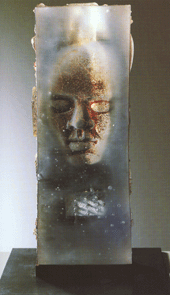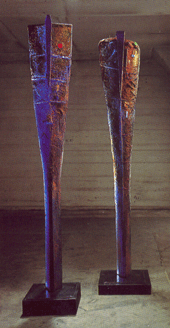|
Throughout
the 90s and up to the present, BV has worked with sculptural themes
containing contradictory elements: destructive dissolving forms
contra the pure and sublime. A number of powerful pieces were created
during these years and represent a trial of strength in his artistic
career.
During
the years 1989 and 1990 Bertil could completely concentrate on his
free creativity. He added a number of sculptural forms to his repertoire,
such as the rod and the ring. Linking together basic shapes to form
a narrative, which was realised by various methods and manipulations
before and at the actual moment of sandcasting. The work now took
on an expressive appearance. The sand mould was prepared so that
cavities were formed, later the molten glass was to decide the outer
structure/texture of the piece. The rough, destructive element was
to be important to BV during the early 90s.
In summer
1991 he showed his latest sculpture in the ruined castle at Borgholm.
The exhibition was entitled Area II and is one of Vallien's greatest
artistic achievements. Here the visitor entered a world of destruction,
with an atmosphere of intense anxiety. Area II consisted of three
different sculptural motifs; "Maps" - square slabs of
moulded glass whose rough surfaces are inscribed with meaning**
They are not really maps at all, more like grave inscriptions or
undecipherable keys to an extinct civilization. In the 90s he introduced
cobolt blue moulded glass. To him this represented the blue of the
universe, the sea and sky. The second part of the exhibition consisted
of "Findings" - a glass block half a metre high. Here
traces of death are sealed into the hardened glass. The occasional
opaqueness of the surface underlines the feeling of being confined
in a burial vault.
The third
and last motif was the threatening "Watchers" - inexorable
guardians of the dark secrets of their time. With their considerable
height of two metres, and bladelike, broad-shouldered upper half,
they emanated a powerful threat. GL:
"The
Area II exhibition was a journey in time through the history of
mankind as also a shattering reflection of the explorations of future
archeologists into the cruel morbidity of our civilisation. But
the installation is also ambiguous; amidst the outer features of
destruction, there are signs of life."
BV continued
to explore new sculptural themes. During 1993-4, he worked with
smaller wall sculptures in three themes which he named, Faces, Kandy,
and Constrict. Here too, he continued to explore the inner and outer
conditions of human life.
"Faces" consists of sandcasted masks with a small opening
to reveal the inside of the mask. While Constrict, with its blue
glass body bound with rings, is a feat of technical virtuosity.
GL is
of the opinion that Bertil, in his desire to explain the riddle
of mankind, raised the artistic temperature to such an extent as
to practically stifle creativity. Vallien found himself in a frustrated
phase of his artistic career and began working with a more universal
subject such as the boats.
At this
time he saw a newspaper article about a girl named Karolina Olsson,
who in the year 1875, had fallen on the ice at Kalmarsund, and thereafter
remained unconscious for 33 years. On awaking from the coma, she
related her memories of that time: just darkness and some blue men.
Bertil began on a new theme in 1994, the head. His version of the
blue men was a series of lifesized heads in clear blue glass. The
sandcasting technique lends itself well tothe ice-cold, introverted
magnetism of "Heads". The rooms of Borgholm castle ruins
were invaded by the blue men in 1995. Visitors were obliged to walk
carefully among the high stone pillars on which the heads were mounted.
They stared down at us one minute, only to disappear like a gust
of wind the next.
"Heads" are a universal form that exerts the same power
on all alike; they also contain ambiguity: are they dead matter
or ethereal spirit? With the head Bertil moves toward a a more rudimentary
world, allowing him to concentrate on the sculptural detail.
GL places him alongside Picasso:
"Vallien's sculptures/incorporates in his work elements
of African religious art and Picasso's formal approach, but his
treatment of the material is unmistakeably his own. Thus...his portrait
heads are consistent with contemporary attitudes; their complexity
makes them at once recognizable and elusive."
The facial
shape of all the Heads are more or less stylised. But with details
such as nails, wire, polishing and surface treatment of the glass
he creates a varied emotional atmosphere. In 1998 he created a series
of heads in repose named "Resting Heads".They represent
a further simplification of form. These exquisitely keyed sculptures
consist of a painted head encased in a matt, semi-transparent layer
of thick glass They are restful, but also frightening in their dual
role as bearersof life and death. This sculpture is the result of
a new method that Vallien devised; it is cast in two parts, glued
together and polished. The same year he holds one of his biggest
and most important exhibition at the Royal Museum of Antiquities
(Historiska Museet), Stockholm. It was a powerful experience to
enter the museum rooms. Taking place within these walls was a fervent
and overpowering display of work,where the glass vibrated with an
inner light. Gone was the anguished vision of the future of Mankind
that characterised Area II. There is still a destructive tone in
Findings and Landings, as a reminder that no one can walk safely
in the path of evil. But the other sculptures express hope and a
loyal unswerving belief in mankind's spiritual strength.In this
exhibition the public saw "Idols" for the first time.
Miniature masculine figures, attached to the wall by a metal plate,
like so many powerful household gods.
From
1998 to the present thematic content has veered somewhat from historical
and human questions, in a search for the illusive inner light. In
"Bridge" from 1998 Vallien places a sandcast blue stave
on metal stand.Two years later he produced blocks of glass with
painted faces& people - calling the subject "Asleep/Awake".
It was a step towards painted imagery on glass.
Somehow
BV has accepted that he is unable to give an answer tothe riddles
of mankind. Art can evoke questions, it can nourish the imagination
and enrich a person. Glass eats light and is still hungry. Why give
an answer when one can search? Bertil continues to experiment. We
await his next move.
|

Map
III, sand - casted 1990. Photo: Göran Örtegren. Metropolitan
Museum of Art i New York, USA.

Finding
man,
sand - casted 1989. Photo:
Anders Qvarnström.

Watchers
,
sand - casted 1989. Photo: Anders Qvarnström

Face,
1992.Photo: Anders Qvarnström.

Head
VI, 1996. Photo:
Göran Örtegren.

Resting
heads, sand - casted 1998. Photo: Göran Örtegren.

Head,
sand - casted 1998. Photo: Göran Örtegren.

Bridge,
1998. Photo Anders Qvarnström.
|


